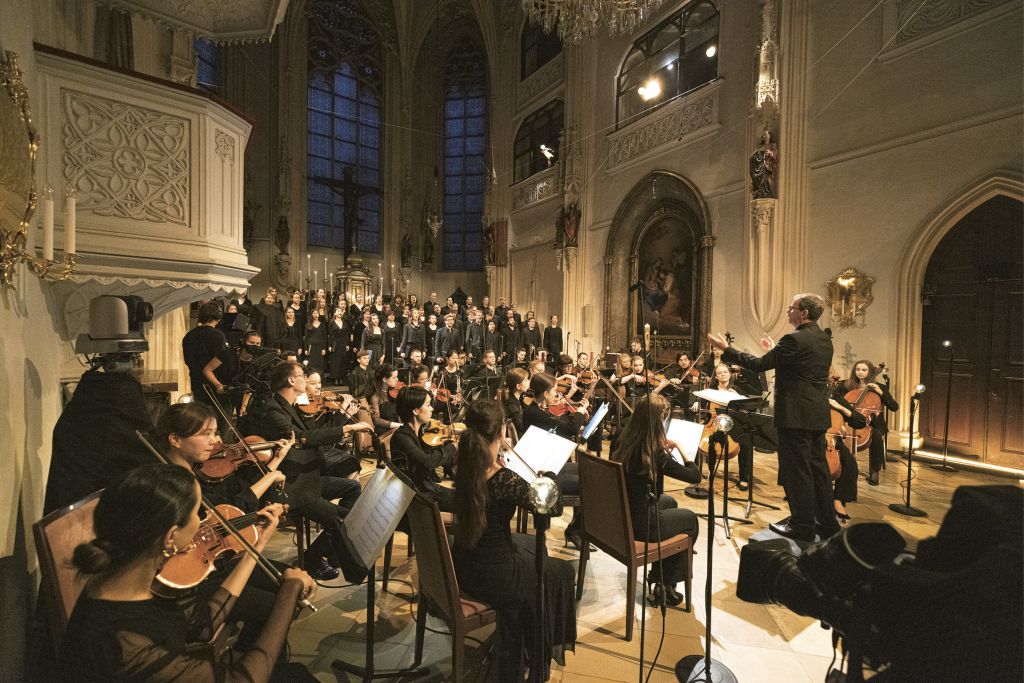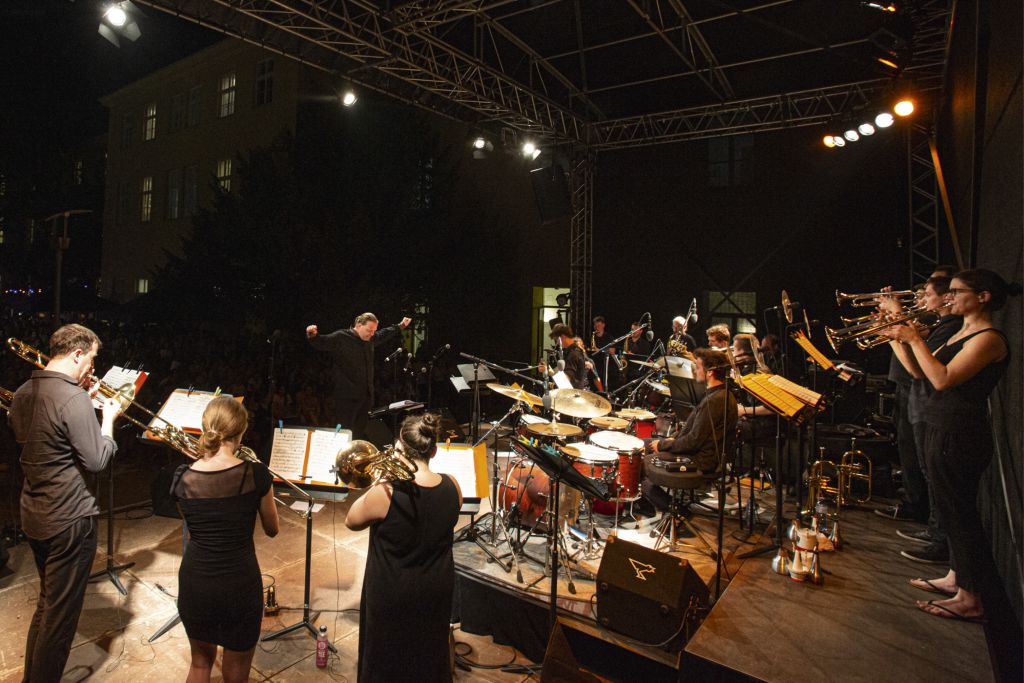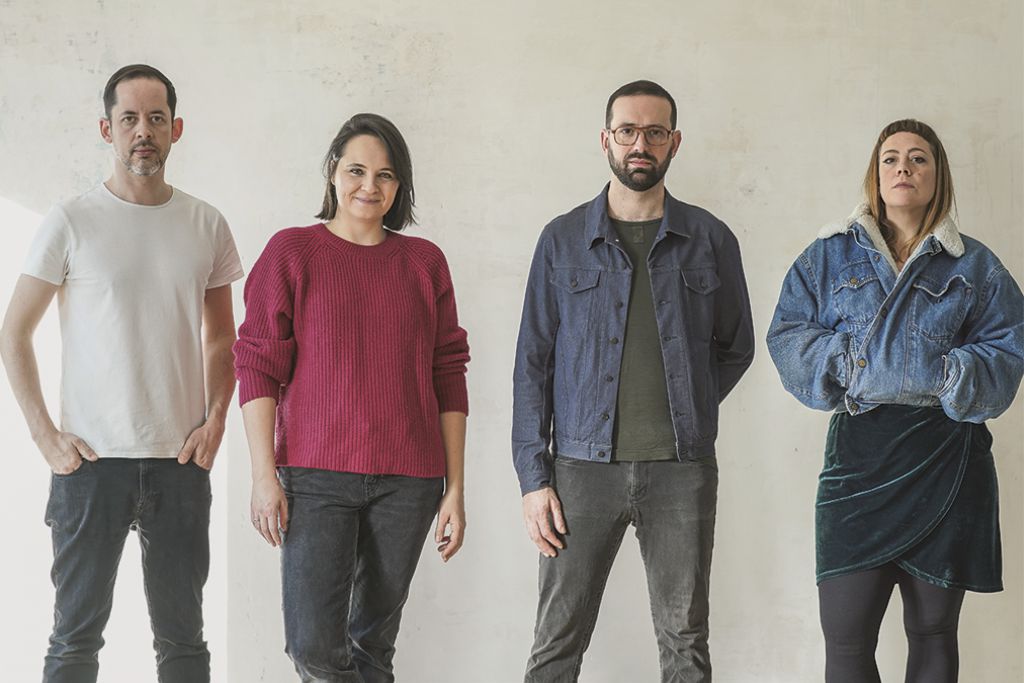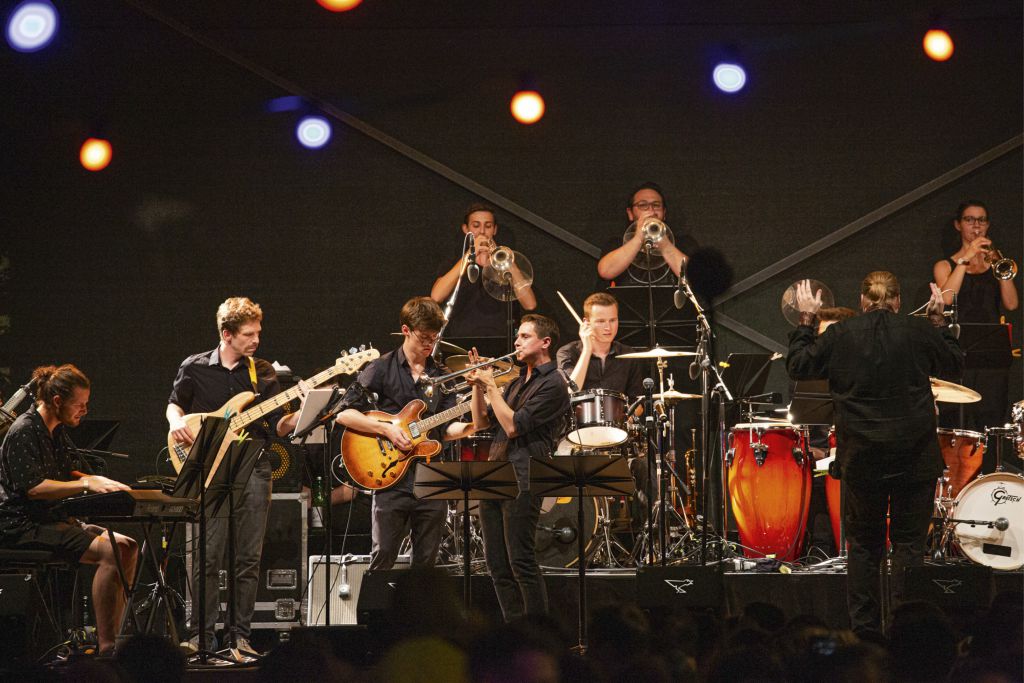Just how it is when all instruments suddenly fall silent, when rounds can no longer be sung, and when orchestras and choirs have to abruptly stop working was made clear to all of us by the past year. But playing as a group, singing in a choir is about far more. An exploration with Alois Glaßner, professor of choral conducting at the mdw and director of the WebernKammerchor, Markus Geiselhart, a composer who teaches big band conducting at the mdw, and Flavio Marchetti, who founded his production company La Banda Film as a collective.

“Ensemble” is a word we use both in music and in theatre. This word’s literal meaning in French is “together”. But is it actually possible to be creative as a group, or is the creative aspect left to the individual standing in front of a choir, an orchestra, or a band?
Alois Glaßner (AG): I can shed some light on this from a choral perspective. What we’re talking about here is this tension between the collective and the individual, the idea of contributing with all of one’s abilities and possibilities while still remaining part of a greater whole. It’s a highly specific situation, and it’s very healthy insofar as neither an over-the-top attitude of “I’ve got to rescue the world” nor the urge to hide within the ensemble will get us where we want to go. Choirs challenge people to involve themselves, but they don’t permit anyone to dominate. Which is why I think that a choir is a wonderful laboratory in which to learn how to work in a team.

Markus Geiselhart (MG): Making music as a big band always involves having individual soloists emerging from the collective, which gives them the opportunity to put their very own stamps on the music through improvised solos. But afterwards, it’s important to merge back into the collective. And just like in any other ensemble, a big band or jazz orchestra requires its members to listen to each other.
You founded La Banda as a film collective. You function as the producer, which is to say that you’re the boss. So how does collaboration play out in your case?
Flavio Marchetti (FM): I reject the term “boss”. I don’t much like calling myself that because in lots of people’s heads, it conjures up the cliché of some cigar-smoking guy tooling around in a convertible. That’s not how I am, nor is it how I want to become. I view myself as a facilitator. La Banda consists of four people: alongside myself, we also have a director and screenwriter, a cameraperson, and an editor. From the get-go, working as a collective was our strong point. Back when we were students 20 years ago, what you got taught was that filmmaking was the lonely, ingenious undertaking of a solitary individual. But we rejected this model. And in doing so, we turned out to be pretty successful compared to others who’d placed no importance on social exchange or collective work.
Conducting is something that’s also viewed as the domain of geniuses, right? So how does one manage the balancing act between leadership and being part of a greater whole?
AG: People do indeed view conducting as the sole remaining refuge of absolute authority. But that impression is a holdover from the late romantic era, when the profession as such solidified. Today, that kind of purely authoritarian approach no longer works. At the rostrum, the point is to initiate and shape a musical process together with the ensemble. What you do is of an indirect character, because you need to win a collective over to your ideas. So these days, conducting is more about bringing something into focus than it is about doing something. But you still do need a creative will—that’s crucial.
MG: Conveying and mediating are also what leading a big band is about. But just how this takes shape depends on the type of ensemble and the rehearsal time that’s available. With students, the point is more to familiarise them with differing stylistic tools and to also do things like have them experience how it is to breathe together. With professional bands, on the other hand, you often have very little time to rehearse—which means you don’t really have the opportunity to initiate reciprocal creative processes. But collective work is indeed about cross-pollination in terms of ideas, about creativity, and about listening to each other. Which are all really important elsewhere in life, as well.
So does it end up influencing people’s “other” lives?
AG: It absolutely does. And you really can sense whether someone was socialised in an ensemble or in a more soloistic environment.
FM: I view film-related work as simultaneously being relationship work. There’s a need for emotional intelligence—which entails a willingness to adapt to various ways of working. The idea that filmmaking consists purely in the assembly of individual technical parts is passé. And that’s a good thing.
AG: I’ll second that wholeheartedly. You’re speaking to an absolutely essential part of the process. A choir or an orchestra is an instrument with its own soul and its own preferences, and the true art here is getting a feel for all this. It’s a process that requires sensitivity. And if both sides are sufficiently open to it, magical moments become possible. It’s always a matter of give-and-take—on both sides. Concepts of leadership can differ greatly. And there are even ensembles that play without a conductor—though when people make music together, someone always does function as a leader.
MG: In the big band tradition, there have repeatedly been orchestras with nobody up front conducting. Like Duke Ellington’s group. He sat down at the piano and led from there. But the great big bands of yore played up to 300 concerts each year. And while travelling or on tour, something arose on the interpersonal level that just can’t be replicated in everyday rehearsing. And it’s a real shame—for today’s students, too—how that’s increasingly fallen by the wayside as big tours by big jazz ensembles have grown rarer and rarer.
FM: In the film world, you ideally see a collective develop during filming itself, at the latest. And when the director gets overburdened or starts feeling insecure during filming, he or she will ideally resort to this collective’s expertise and sense of responsibility. They can then work together to get things back on track. But if a director retreats into denial about being overwhelmed and adopts a more authoritarian leadership style, the collective will fail to realise its full potential.

Isn’t it also possible for an orchestra to compensate for a conductor’s weaknesses?
AG: What’s crucial is an internal need to shape something, and then it’s about the high degree of communicative skill that’s required for someone to convey their notions to a collective and initiate a process that allows something to take shape. In a symphony orchestra, you have clear structures; it’s largely a self-organising whole. And for this reason, a good orchestra can indeed come to the rescue if the conducting is weak. It’s different with a choir, though. In a choir, the people themselves are the instrument. And this instrument needs to be enabled and actuated by singer-adapted, breath-led conducting. Which is to say that bad conducting affects a choir far more directly.
MG: But you can also hear this in an orchestra.
AG: The settings always differ, but the models of collaboration are fairly universal.
MG: It really depends who I’m working with. What you’re conveying or how you convey it is always the same. When I get up in front of a band, I view myself as part of a whole. And it’s also about generating and radiating energy. The musicians are the most important thing to the conductors, and the most important thing in conducting is giving the individual musicians a feeling of self-confidence. Looking at a musician right before the attack can be of great help to him or her. But there are also conductors who’ll tend to exacerbate a musician’s fear before the baton drops.
In film, “conducting” is done from the director’s chair. How important are a team’s individual members, like the editors or camerapeople?
FM: There does exist this romanticised idea of the genius-director who does everything alone. And there are indeed some exceptional filmmakers, above all in the area of documentaries, who do quite a bit by themselves. But even in films like those, it’s still the case that some sort of collective work is always present. Filmmaking lives from a certain tension. It involves the integration of various different concepts and ideas to result in a shared filmic language. This process can involve quite a bit of friction, but that’s also what so great about it.
How are things when it’s a woman at the rostrum or in the director’s chair? Some people might ask why there aren’t any women participating in our discussion here. What kind of a balance is there among faculty?
FM: 20 years ago, when I was a student, the Film Academy faculty’s share of women was catastrophically low. And while we do now have women teaching artistic subjects, we’re still far off from equal representation.
AG: Last year, nearly equal numbers of women and men got admitted to the conducting programme; this year, we once again ended up with a clear male majority. So we’ve still got a long way to go. Notions are slow to change where gender roles are concerned. And women don’t yet have such an easy time building up the confidence to take on leadership roles.
MG: I think this is has to do with socialisation, and that begins all the way back in preschool. It also has to do with what instruments are available. I play the trombone—and like most trombonists, my musical origins are in a brass band. Back then, no one there would’ve thought to offer a girl a low-pitched brass instrument. And I’m afraid that in many places, things still haven’t changed much.
Is it a similar situation in film?
FM: We’re dealing with some fixed notions there that need to be gotten rid of. I see a huge degree of similarity between film and music when it comes to equality: we’re all still back in the Stone Age. It’s associated with lots of factors—including how it was long the case that there simply weren’t any role models.
MG: Or at least too few! And role models are really important.
FM: Over the many decades of cinematic history, male role models and archetypes have been dominant. With men as the heroes and women purely as objects of lust. It’s a phenomenon that’s become so integral to our perception that we’re not yet at that point where we can liberate cinema from the male gaze once and for all.
This September, the Metropolitan Opera in New York opened its season with an opera by Terence Blanchard. He became the first black composer to have a work performed at the Met. But where are the black conductors?
MG: In the United States, it was once the case that people of African descent weren’t even able to attend classical concerts—or you had separate concert venues for blacks and whites. And there’s also this story about Frank Sinatra performing with Tommy Dorsey’s orchestra. That was a white band—and when Sy Oliver, their black arranger, wasn’t allowed to stay at the same hotel as the band, Sinatra got physical. That happened in the 1940s. And I’m afraid we’ll still be needing one or two generations yet before that’s entirely a thing of the past.
FM: Some people are disadvantaged, and there are also minorities who have a harder time gaining admission to certain types of training. And if I’m someone who experiences discrimination in everyday life, my path towards a leading role in an artistic profession can turn into something of an obstacle course.
MG: In jazz, the situation was initially more the reverse. Jazz was a style of music that black people had played a huge role in shaping—and some of them then questioned whether white people were capable of playing it. However, the past 70 years have seen the development of an unbelievably interesting European jazz scene. So it all has a lot to do with role models, and it’s awful just how much seems set in stone. So the point now is to focus on disrupting old role models so that everything will be possible for everyone.
FM: This is why we need measures like gender quotas in the film industry.
MG: I think that role models are far more important.

Isn’t there a danger that quotas will exclude quality?
FM: By no means. Austria is the first country to have introduced equality-promoting measures of this type. What we have is a step-by-step model that aims to put men and women on an equal footing in terms of the funding that’s awarded, a model in which the artistic quality of the submitted projects is extremely important. The idea of a “threat to quality” is simply the rhetoric of those who view quotas as a threat to their privileges. Which indeed they are. I’m supportive of this model because we can no longer wait for change to happen.
AG: Quotas are always stopgap measures. But they can provide impulses in certain situations. We always need to be aware of the context in which we’re operating, though. At auditions for orchestra positions, nobody can see who’s playing behind the curtain. But it’s different when there’s a leadership position to be filled: you can’t fill such a position blind. Still, I think a quota would be problematic in the field of conducting because we don’t yet have the necessary qualitative breadth in all of the relevant areas. And for this reason, support and enrichment measures are absolutely necessary and important. As are successful female conductors who can act as role models.
Does one come to value working together with others all the more after months of isolation and streamed concerts?
MG: When you sing or play together, it gives rise to a certain kind of energy. And as for a concert situation where you directly experience the ensemble, where the audience can feel this energy, where you can feel the audience’s energy yourself: there’s nothing that can replace that, not even streaming.
The same type of energy probably doesn’t exist in film.
FM: Oh, it does! Like when you present the film you’ve created together to an audience at a sold-out cinema. We may be living in the era of streaming providers, but we can’t allow ourselves to forget that cinema is still a collective experience!
AG: The fascination of working on a big, shared whole that’s more than the sum of its parts is something you can feel. You’re part of a collective where the individual members amounts to something greater, which is one aspect of why we make music together. And as pathetic as it may sound: it really is kind of addictive.

